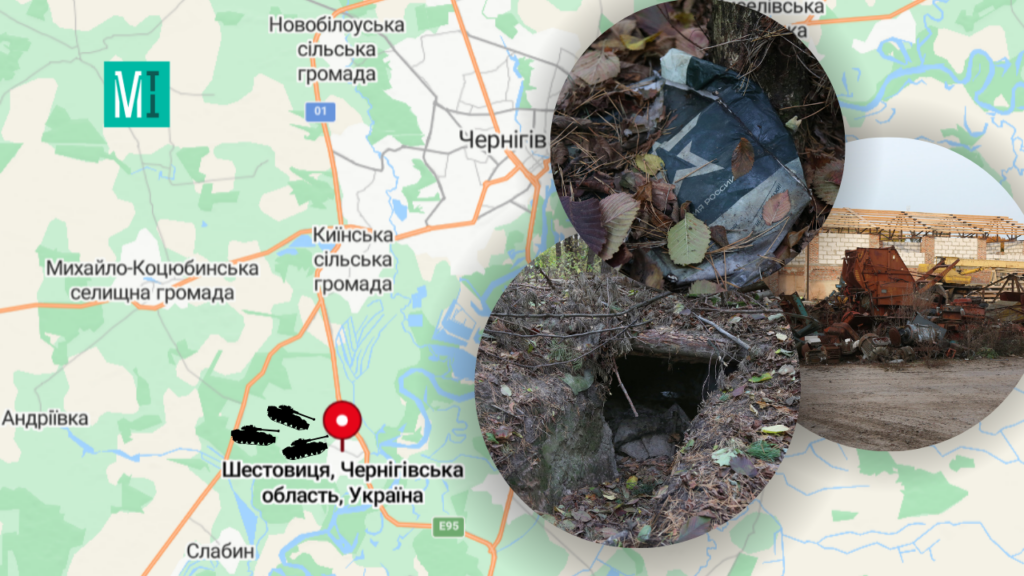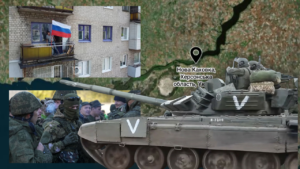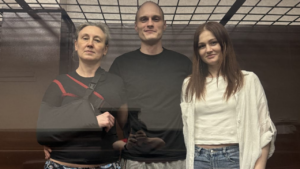How the Russians occupied Chernihiv Region: names of commanders and alleged perpetrators

“We came to liberate you.” This is how Russian invaders responded to the residents of Chernihiv Region in February-March 2022. During this time, they committed numerous crimes against civilians. To document these, MIHR went to the village of Shestovytsia, where in March last year Russian troops established their headquarters.
The village of Shestovytsia is located near the Desna River, 20 km northwest of Chernihiv. It lies on the M-01 Kyiv – Chernihiv – Novi Yarylovychi international highway. Attempting to slow down the enemy, the Ukrainian Defense Forces blew up the Shestovytsia bridge across the river. However, on February 28, around 11 a.m., enemy vehicles still entered the village. The first to arrive were scouts, disguised as Ukrainian troops.
“I felt the ground rumbling. I looked through the fence, and about five tanks were driving down Kolektyvna Street. All barrels were turned to a side, and the tanks had yellow and blue ribbons tied on them. They seemed like our troops. They drove around the corner, then the ground rumbled again. And again a convoy of tanks, but now with red ribbons, drove past. Buryats were sitting on the tanks. The barrels were also turned to a side, but when they reached the intersection, they turned them straight. Then they drove on like that,” says local resident Iryna. There was no battle, according to her.
Russian headquarters at the farm
Witnesses say that enemy vehicles with “O” and “Z” markings entered from the village of Mykhailo-Kotsiubynske, went to the center of Shestovytsia, then headed to the Chernihiv – Kyiv highway. The shelling began there, so the Russians returned to the village. Some of the enemy vehicle were located on the western outskirts of Shestovytsia on the grounds of the Lan farm, owned by the Luhina family. One of its members, Oleksiy Luhina, recounts that on the morning of February 28, he drove a Ukrainian soldier who got lost in Shestovytsia to Yakubivka. Just a few hours later, a Russian tank unit entered the village and occupied the farm. The man recalls: “My brother Serhiy was in the garage on the farm at the time. They entered, pointed a gun barrel at his abdomen, and ordered him to show what was there. They found 40 cubic meters of diesel fuel, brought over their tankers, pumped it all out in an hour or two, and left.”

Oleksiy Luhina. Photo by Victor Kovalchuk
The Russians also set up their headquarters on this farm. “They set it up in the garage,” Oleksiy Luhina says.
“They left behind cabinets and pallets on which they slept. On the other side in the corner, they set up their medical station to treat their wounded. After they left, we cleared out bloodied tampons and other trash. In the room next door, the Russians held two prisoners.”
The Russian military also installed a radio reconnaissance vehicle on the farm. Villagers were forbidden to walk through the village unless absolutely necessary or to use phones. They were allowed to lock doors only at night.
Other Russian units also arrived in the village. Locals don’t know the exact number of Russian soldiers. They say there was an enormous number of vehicles – at least 500 units. They were positioned all over the village, almost at every house: tanks, APCs, self-propelled guns, IFVs, missile systems, etc. The vehicles were also in the fields and the forest near Shestovytsia. There, the Russians began constructing fortifications.

Bunker. Photo by Victor Kovalchuk
Macaroni cakes
Residents of Shestovytsia remark that among the Russian soldiers who entered the village, most had Mongoloid facial features – Buryats and Tuvans. There were also some who appeared to be Slavic, but not many. The Russian soldiers did not have any insignia on their uniforms. However, they wore red or orange-and-black ribbons. A lieutenant general commanded the Russians in Shestovytsia. His name is unknown; in conversations with villagers, he mentioned he had Ukrainian roots and that among the military occupying the village, 30% were representatives of the so-called “L/DPR,” attached to Russian units. There were also representatives from Kryvyi Rih and Sumy region who served on Russia’s side. This was accidentally discovered. A man from Kryvyi Rih lived in Shestovytsia. When Russian soldiers came to his front yard for inspection, he recognized a fellow native of Kryvyi Rih by his distinctive accent. That man confirmed he was from Kryvyi Rih and said he had signed a contract to serve in Russia. Russian servicemen also mentioned that many of them had previously fought in Syria.
“After entering the village, they were everywhere like ants. Mostly Buryats – with puffy faces,” recalls local resident Iryna. “There were also Tuvans in the village, but they were thin-faced. We later began to distinguish them. They came in with guns into my front yard, poking around everywhere. I asked, ‘Are you lost? The gate is over there.’ And another Buryat was already opening the refrigerator in the house. I said to him, ‘Did you put something in there?’ He said, ‘No.’ – ‘Well, then please close it, thank you.’”
They said they came to liberate us from Nazi-Banderites. They themselves looked like dirty vagrants, were hungry, slaughtered all the livestock in the village – pigs, geese, chickens. On one occasion they came into the front yard: ‘Give us some eggs and a chicken.’ – ‘What will I feed the children with? You shot all the chickens!’” According to Iryna, the Russians even ate dogs. Later, they brought a military kitchen, which they set up on the farm.
As soon as the village became occupied, the locals experienced a shortage of food and water. Stores were closed.
“They arrived on Monday, and on Tuesday we lost power and water supply. Around March 3-4, 2022, the gas supply was also cut off. It was difficult, but people rallied, tried to help each other,” says village elder Serhiy Medvedyev. “In the first days, villagers almost didn’t go out on the streets, only to the well to fetch water. The Russians needed water too, they drained the well down to the sand.” The elder recalls that there was no bread in Shestovytsia, but a truck with pasta remained – the driver couldn’t pass through the village in time. People bought pasta from him, soaked it, and made cakes. Later, when the Russians withdrew from the center of the village to the forest, some women rode bicycles to the neighboring Kiyinka for humanitarian aid.

Serhiy Medvedyev, Village Head of Shestovytsia. Photo by Victor Kovalchuk
Searching for “Nazis”
Walking around the village, the invaders asked which city they were in, not believing it was a village. Witnesses recount:
“They were surprised: ‘You even have asphalt? Gas, water, and sewage in the houses? So, it’s a city, right?’ – ‘No, it’s a village. Derevnya in your language.’ When locals urged them to leave, they replied that they had no way back: either prison or execution awaited them. They also mentioned their families’ disdain.
Village resident Iryna recalls how the Russians searched for “Nazis”: “My neighbor is a military man, in service. He wasn’t home. They went to his house, rummaged through it, found a uniform. They come to me, ask about him, saying they found Nazi uniform. I tell them: ‘That’s not Nazi, that’s ours.’ I didn’t know then that they considered all of us Nazis.” Iryna remarks that the Russians strictly ordered that male family members should stay inside the house and not go anywhere, even in their own front yard. If they needed to go outside, a woman had to accompany them. “I have a teenage grandson,” says Iryna. “So I say to the Russian soldier, ‘He’s just a child!’ But he grimly responds, ‘Still a Nazi’.”
The family was closely monitored. Once in the evening, they saw a drone shining a light into their windows. Another time, Russian soldiers came for the phone. “We took our phones apart and hid them, but I left an old button phone to call relatives in Chernihiv, to tell them we’re alive. One day, a young conscript comes: ‘Auntie, let me call my mother, it’s her birthday.’ I tell him, ‘I don’t have a phone.’ He says, ‘We know you do, we listened in.’ I gave the phone, and he told his mother he was ‘undergoing training’.”
From the first days of occupation, Russian soldiers engaged in looting: stealing phones, warm clothes, shoes, generators, other valuable items. They also moved into the houses of locals, either while the owners hid in cellars or evicted them from their homes.
Oleksiy Luhina recounts that their house was visited several times, including by the FSB. The first time they just inspected the house. When they came the second time, Oleksiy’s mother protested, saying there were 24 people in the cellar, including eight children. “There were three Slavic-looking men. The group leader said he would check himself without a gun. He went into the cellar, met my child, and it made an impression on him. He came out and said, ‘Guys, where have we come? There are so many children here’.”
Later, Tuvans and Buryats came to the Luhinas’ house: “16 men ransacked the house, took everything valuable. They stole my childhood coin collection. They dismantled and smashed the car – only the body remained.”

Oleksiy Luhina shows a photo of the destroyed car. Photo by Victor Kovalchuk
The Russians didn’t shy away from underwear. “They were here for a month instead of the three days they had dreamed of, and had nothing with them, so they took clothes from the locals. They even put on women’s underwear, throwing away their own. I found their underpants under my fence,” recalls Iryna.
As Oleksiy Luhina explains, Russian soldiers with Slavic features warned that arguing with the Tuvans was risky, as they didn’t understand Russian and could perceive any displeasure as an insult, leading to immediate stabbing. Iryna adds that they walked around the village in either green camouflage or light-brown uniforms. Once, soldiers warned her that if military personnel in black-red uniforms arrived, it was better for the locals to hide and conceal all tools and valuables. They mentioned such forces were stationed in neighboring Mykhailo-Kotsiubynske, but troops in such uniforms were not seen in Shestovytsia.
Crossing the Desna and occupation of other villages
Various units of the Russian Armed Forces were based in Shestovytsia, including units from the 41st Combined Arms Army of the Central Military District, which, according to the reports of the General Staff of the Armed Forces of Ukraine, tried to take control of Chernihiv near its southern outskirts.
While in Shestovytsia, Russian troops fired towards Chernihiv, Kyiv, Ivanivka, and Kolychivka. They tried several times to establish a crossing over the Desna to bypass Chernihiv from the south. The enemy succeeded in building a pontoon crossing in early March. Some of the Russian units, having crossed the river, headed towards Zolotynka and Yahidne, occupying them on March 3, 2022. Two days later, they captured Ivanivka.
The Ukrainian Armed Forces gradually drove out the enemy, striking their locations. On March 8, 2022, Ukrainian soldiers destroyed a convoy of Russian vehicles on Kolektyvna Street in Shestovytsia.

The presumed site of the destruction of a Russian crew of the Storm anti-tank missile complex. Screenshot from a news report by Suspilne
“It was scary,” recalls Iryna.
“There was a cluster of Russian vehicles on this street. Two vehicles with ammunition, fuel trucks, and a military kitchen were destroyed here. The shock wave was powerful; we barely managed to hide. Debris was flying everywhere.
Rumor had it that someone local gave our troops the coordinates. Then there was so much metal left behind – it was impossible to walk down the street.” According to locals, the Ukrainian forces killed about 50 Russians. The attack also damaged local houses, which are now being repaired. There were no civilian casualties.

Kolektyvna Street. Photo: Google Maps screenshot

Remnants of vehicles on the grounds of the Lan farm. Photo by Victor Kovalchuk
The street is now cleared of Russian scrap, but the smell of ashes still lingers.
After the successful attack, Russian soldiers retreated from the village into the forest. “They left quickly. They lived in an empty house not far from us, and set it on fire upon leaving,” says local resident Halyna. The Russians set up a new headquarters at a mushroom-growing enterprise, as locals call it – “on the mushrooms.”

Photo from the location of Russian troops in the forest near Shestovytsia
Traces of Russian military positions remain. The photo shows a bottle of Arzhaan Senek water from the Ulug-Khemsky district of the Tuva Republic, Russia.

Remains of a Russian ration. Photo by Victor Kovalchuk
On March 31, 2022, the Armed Forces of Ukraine liberated Shestovytsia. The Russians retreated hastily, leaving behind mined equipment and ammunition. According to the estimates of the Operational Command “North”, the enemy’s losses in the area reached 40% in vehicles and personnel over the month.
Crimes against civilians: names of the suspects
One of the units involved in the occupation of Shestovytsia was the 55th Motorized Infantry Mountain Brigade of the Russian Federation (military unit 55115), based in Kyzyl, Republic of Tuva. This is confirmed by witnesses MIHR spoke to. The brigade commander was Denis Barylo, a colonel at the time, who was promoted to major general in June 2023.

Denis Barylo
Another identified unit is the 74th Separate Motorized Infantry Brigade of the Russian Federation (military unit 21005) from Yurga, Kemerovo region under the command of Lieutenant Colonel Pavel Yershov.

Pavel Yershov
Back in April 2021, as reported by the Russian media, this unit from Yurga was transferred to the Voronezh region, closer to the Ukrainian border. The official version of the Russian authorities was “training”, during which they were to practice “actions to transfer and deploy mobile components of the control system and march to the designated areas.” On February 24, 2022, during the invasion near Chernihiv, a reconnaissance platoon of the 74th Motorized Infantry Brigade surrendered. Platoon sergeant Konstantin Buynichev confessed that they received the order to advance into Ukraine on February 23, 2022. This proves that the invasion of Ukraine was not spontaneous; it was planned in advance.
One of the servicemen of the 74th Brigade, Eziz Akiniazov from Kazan, was charged with illegal detention and cruel treatment of civilians (Part 2 of Article 28, Part 1 of Article 438 of the Criminal Code of Ukraine).

Eziz Akiniazov. Photo: Judicial Reporter
In particular, the investigation materials indicate that several Russian soldiers, including Akiniazov, detained a local resident in Sloboda, Ivanivka territorial community, on March 6, 2022. They abused the man – put the barrel of a gun to his temple and put it in his mouth, ran a knife blade across his face, insulted and humiliated him. The man’s hands were tied with wire, and he was taken to Shestovytsia, where he was kept on a farm at temperatures below 0 degrees Celsius. Akiniazov’s case is currently in court. The victim, according to Shestovytsia residents, was released by the Russians on March 7.
This victim is not the only one harmed by Russian soldiers in Shestovytsia. On March 15, 2022, Russians shot at three cars with civilians evacuating from the village. As a result, a man was killed, a girl suffered a severe abdominal wound and died later, and several people were injured. Another victim, a man, died in the hospital from wounds received on February 28 during the shelling of the former Shestovytsia airfield by the Russians. His son committed suicide due to the stress.
While on a field mission in Shestovytsia, MIHR also learned that during a house check, Russian soldiers threw a grenade into a cellar where a family was hiding. The head of the family suffered severe injuries. Another local resident was shot by Russian soldiers as he was leaving the village on a bicycle – his relatives could only retrieve and bury the body after the village was liberated. After liberation of Shestovytsia, law enforcement found several more bodies of tortured men: a resident of Mazhuhivka village, two brothers from Desnianka, and a resident of Koriukivka. In October 2023, another tortured man’s body was found in the forest. Preliminary findings show that he was a resident of Mykhailo-Kotsiubynske. The fate of Oleksandr Shcherbaty, a resident of Shestovytsia kidnapped by the Russians, remains unknown.
This article was prepared with contributions from Kateryna Ohiyevska.






